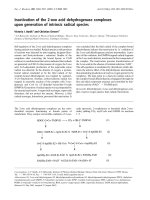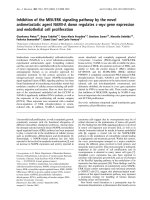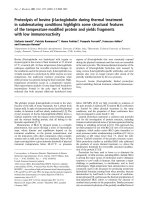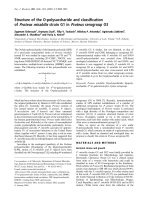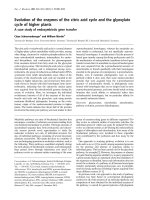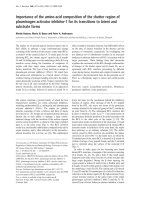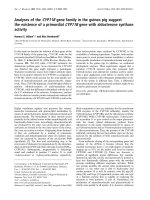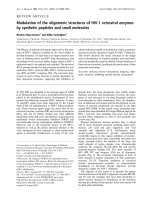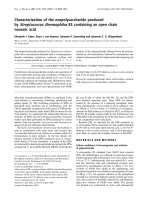Báo cáo y học: " Deletion of the meq gene significantly decreases immunosuppression in chickens caused by pathogenic marek’s disease virus" pptx
Bạn đang xem bản rút gọn của tài liệu. Xem và tải ngay bản đầy đủ của tài liệu tại đây (766.09 KB, 8 trang )
RESEARCH Open Access
Deletion of the meq gene significantly decreases
immunosuppression in chickens caused by
pathogenic marek’s disease virus
Yanpeng Li
1†
, Aijun Sun
2†
, Shuai Su
2
, Peng Zhao
2
, Zhizhong Cui
2*
, Hongfei Zhu
1*
Abstract
Background: Marek’s disease virus (MDV) causes an acute lymphoproliferative disease in chickens, resulting in
immunosuppression, which is considered to be an integral aspect of the pathogenesis of Marek’s disease (MD).
A recent study showed that deletion of the Meq gene resulted in loss of transformation of T-cells in chickens and
a Meq-nu ll virus, rMd5ΔMeq, could provide prot ection superior to CVI988/Rispens.
Results: In the present study, to investigate whether the Meq-null virus could be a safe vaccine candidate, we
constructed a Meq deletion strain, GX0101ΔMeq, by deleting both copies of the Meq gene from a pathogenic
MDV, GX0101 strain, which was isolated in China. Pathogenesis experiments showed that the GX0101ΔMeq virus
was fully attenuated in specific pathogen-free chickens because none of the infected chickens developed Marek’s
disease-associated lymphomas. The study also evaluated the effects of GX0101ΔMeq on the immune system in
chickens after infection with GX0101ΔMeq virus. Immune system variables, including relative lymphoid organ
weight, blood lymphocytes and antibody production following vaccination against AIV and NDV were used to
assess the immune status of chickens. Experimental infection with GX0101ΔMeq showed that deletion of the Meq
gene significantly decreased immunosuppression in chickens caused by pathogenic MDV.
Conclusion: These findings suggested that the Meq gene played an important role not only in tumor formation
but also in inducing immunosuppressive effects in MDV-infected chickens.
Background
Marek’s disease (MD) is a neoplastic disease of chickens,
which is caused by t he lymphotropic alphaherpesviru s,
MD virus (MDV). MD i s characterized by the develop-
ment of T-cell lymphomas and lymphocytic infiltration
of peripheral nerves, skin, skeletal muscle and visceral
organs [1-3]. Infection with MDV and subsequent devel-
opment of MD is frequently associated with immuno-
suppression, which is considered t o be an integral
aspect of MD pathogenesis that ultimately leads to the
death of many chickens in a number of cases [4,5].
To search for oncogene(s), early studies focused on
the genes expressed in tumor cells. It has been shown
that the transcriptional activity of MDV in tumor cells
was confined to the R
L
regions. And Meq [6], pp38 [7]
and the BamHI-H family which includes a 132 bp
repeating region [8-10] are unique to MDV among the
R
L
-encoded genes. Inoculation of MD-susceptible birds
with a pp38 deletion mutant virus revealed that pp38 is
involved in early cytolytic infection of lymphocytes, but
not the induction of tumors [11]. Recently studies
showed that the mechanism of attenuation of MDV
does not involve the 132 bp repeat region [12]. Among
these genes, only Meq is the most consistently expressed
in latent phase [6] which is present in serotype 1 strains,
but not in the non-oncogenic serotype 2 and serotype 3
strains [13,14]. Meq is a 339 amino acid protein, charac-
terized by a N-terminal bZIP domain which is closely
related to the Jun/Fos oncoproteins and a proline-rich
C-terminal transactivation domain [6]. Down-regulatio n
of Meq resulting in the loss of the colony formation
ability o f MSB1 [15], over-expression of Meq resulting
* Correspondence: ;
† Contributed equally
1
Institute of Animal Sciences, Chinese Academy of Agricultural Sciences,
Beijing, 100193, PR China
2
Animal Science and Technology College, Shandong Agricultural University,
Tai’an, Shandong, 271018, PR China
Full list of author information is available at the end of the article
Li et al. Virology Journal 2011, 8:2
/>© 2011 Li et al; licensee BioMed Central Ltd. This is an Open Access article distributed under the terms of the Creative Commons
Attribution License (http://creativecommons.o rg/licenses/by/2.0), which permits unrestricted use, distribution, and reproduction in
any medium, provided the original work is properly cited.
in the transformation of a rodent fibroblast cell line,
Rat-2 [16], and the interaction between Meq and
C-terminal-binding protein (CtBP), a highly conserved
cellular transcriptional co-repressor [17], all suggests
that Meq is likely to be one of the principal oncogene
for MDV. The strongest evidence proving that Meq is
an MDV oncogene was confirmed by Meq knockout
experiments [18].
The direct relationship between MDV strains of higher
pathogenicity and greater immunosuppression [4] sug-
gest that Meq perhaps plays an important role in immu-
nosuppression. In earlier studies we cloned the full
length genome of the MDV strain, GX0101, into a bac-
terial artificial chromosome (BAC) and reconstituted the
infectious virus, bac-GX0101 [19,20]. Studies in specific-
pathogen-free (SPF) chickens showed that the virulence
of bac-GX0101 could be classified from virulent to very
virulent, and there was no difference in growth ability
and pathogenicity to birds when compared with its par-
ental virus, GX0101 [19]. In this report, we examined the
oncogenic potential of GX0101ΔMeq, which was gener-
ated by deleting both copies of the Meq gene from bac-
GX0101. Pathogenesis studies in SPF chickens showed
that the MDV-encoded Meq gene is not only a principal
oncogene but also involved in immunosuppression.
Results
Identification of Meq deletion mutant GX0101ΔMeq
Using BAC clones, we generated a mutant virus lacking
both copies of the Meq gene, GX0101ΔMeq. Plaques from
recombinant GX0101ΔMeq a nd control bac-GX0101
viruses were evident after five days following transfection.
To confirm the deletion of the Meq gene, transfected cells
showing plaques were examined by immunofluorescence
assay (IFA) with monoclonal antibody (mAb) H19 and
mouse anti-Meq polyclonal serum. As expected, bac-
GX0101 virus expressed both pp38 and Meq, whereas
GX0101ΔMeq expressed pp38 but not Meq (Figure 1).
GX0101ΔMeq exhibited the same replication rate in CEF
as bac-GX0101
To determine whether the deletion of the Meq gene has
any effect on replication of GX0101ΔMeq in vitro, the
growth rate of GX0101ΔMeqviruswascomparedwith
that of bac-GX0101. At hours 24, 48, 72, 96, 120 and
144 po st-inoculation (p.i. ), the recombinant v irus
GX0101ΔMeq exhibited the same replication dynamics
in CEF as its parental virus bac-GX0101.
Viremia levels of birds infected with GX0101ΔMeq or bac-
GX0101
The viremia levels of birds infected with GX0101ΔMeq
or bac-GX0101 were determined on days 7, 14, 21 p.i.
As indicated in Table 1 , with the exception of days 7
p.i., the viremia levels of GX0101ΔMeq virus-infected
group were significantly lower than that of bac-GX0101
group on days 14 and 21 p.i.
Pathogenicity of GX0101ΔMeq
To determine whether deletion of the Meq gene affects
the pathogenic properties of MDV, chickens inoculated
with bac-GX0101 or GX0101ΔMeq were observed for
mortalityforaperiodof13wee ks. All chickens which
died during the experiment or at t ermination w ere
examined for MDV-specific lesions, including gross
tumors and nerve lesions. As indicated in Figure 2 and
Table 2 one chicken from GX010 1ΔMeq group died on
days 3 p.i. and two chickens from bac-GX0101 group
died due to unidentified causes on days 8 p.i. MDV-
associated mortality was observed in the parental
Figure 1 Immunofluorescence analysis of CEF cells infected
with recombinant viruses. 100 PFU of bac-GX0101 and
GX0101ΔMeq were inoculated into 6-well plates containing a
monolayer of CEFs. The mAb H19 specific for the MDV-unique
protein pp38, and mouse serum against Meq were used for
immunofluorescence analysis. Parental virus, bac-GX0101 expressed
Meq protein, whereas the deletion mutant virus GX0101ΔMeq did
not. The presence of GX0101ΔMeq virus was confirmed by staining
of MDV-specific pp38 protein.
Table 1 Comparision of viremia levels between bac-
GX0101 and GX0101ΔMeq infected SPF chickens (n = 6)
Days post-infection Viremia (PFU/ml)
bac-GX0101 GX0101ΔMeq
7 28 ± 9.8 a 32 ± 6.2 a
14 154 ± 47.6a 69.7 ± 16.5 b
21 256.5 ± 46.8 a 78.2 ± 9.5 b
All chickens were inoculated with 1000 PFU of the indicated virus by a
subcutaneous route. The difference in vivo replication between bac-GX0101
and GX0101ΔMeq was determined by viremia levels. The numbers in the
table indicate: mean ± standard deviation, at days 7, 14 and 21 p.i., and same
letters indicate that the differences were not significant (P > 0.05), different
letters indicate that a significant difference (P < 0.05).
Li et al. Virology Journal 2011, 8:2
/>Page 2 of 8
bac-GX0101 group starting at three weeks after infec-
tion and only six chickens survived in the duration of
the experiment. There was no MDV-associated mortal-
ity in mock- or GX0101ΔMeq-inoculated groups. All
the chickens in the bac-GX0101 group had developed
MDV-specific lesions, whereas none were observed in
either GX0101ΔMeq- or mock-inoculated groups.
Effect of GX0101ΔMeq on immune organ
Statistical analysis showed that the weights of the body,
the relative thymus and bursa in bac-GX0101 group
were significantly lower than the control gro up chickens
and those infected with GX0101ΔMeq (P < 0.05) at 14
days p.i. There were no significant differences between
chickens in the GX0101ΔMeq and control groups (P >
0.05; Table 3).
The chickens infected with bac-GX0101 were grossly
found to have typical atrophy of the bursa of Fabricius
during the whole observation period. Overall, almost all
of the chickens presented with obvious atrophy of bursal
follicles, displayed fibrous connective tissue hyperplasia,
inflammatory exudate and necrotic cells infiltrated in
the follicular interstitium, vague boundary among folli-
cular cortex a nd follicular medulla, rarities of follicular
cortex and loss of lymphocytes in the medullary area of
bursal follicles (Figure 3). Moreover, thymus lesions
lacking structure in the cortex and medulla, necrosis
and disintegration of lymphocytes were also ob served in
some birds infected with bac-GX0101 (Figure 3). No
MD-specific lesions lesions were observed in the control
and GX0101ΔMeq-infected groups.
Effect of bac-GX0101 and GX0101ΔMeq on blood
parameters
The number of leukocytes and lymphocytes in periph-
eral blood progressively increased in chickens infected
with bac-GX0101 and GX0101ΔMeq compared with
those in control group at days 14 p.i. (P <0.05).There
seems to be only minor variations in leukocyte and lym-
phocyte numbers among the three groups at days 24, 31
and 42 p.i. (P > 0.05, Figure 4A and 4B). Chickens dis-
played anemia with the numbe r of erythrocytes progres-
sively reduced on days 7, 14, 24, 31 and 42 after
infection with bac-GX0101 (P < 0.05, Figure 4C), but
the transient reduction in the number of erythrocytes
was apparent in chicken s infected with GX0101 ΔMeq
on days 7 p.i. (P < 0.05). Statistical analysis showed that
there were no significant differences between chickens
in the GX0101ΔMeq and control group s on days 14, 24,
31 and 42 p.i. (P > 0.05, Figure 4).
Comparison of the immunosuppressive effects of two
viruses on antibody responses
To evaluate whether GX0101ΔMeq MDV had immuno-
suppressive effects on humoral immune responses, we
compared the immunosuppressive effects of bac-GX0101
with GX0101ΔMeq viruses on immune responses against
NDV and AIV inactivated vaccines. As expected, we
found that the bac-GX0101-infected chickens exhibited
weaker humoral immune responses against the inacti-
vated NDV and AIV vaccines compared to the control
group on days 28 and 35 after immunization (P < 0.05,
Figure 5). The GX0101ΔMeq-infected chickens showed
similar antibody lever with the control group (P >0.05,
Figure 5). Thes e results indicated that GX0101ΔMeq had
no immunosuppressive effects on humoral immune
responses in chickens.
Analysis of T cell subsets after inoculation with bac-
GX0101 and GX0101ΔMeq
As shown in Figure 6 the percentage of CD8
+
T cells
was drastically reduced in bac-GX0101-infected chickens
on days 21 and 28 p.i. (P < 0.05), however, the percen-
tage of CD4
+
T cells was increased on days 14 and 21
Figure 2 Inci dence of mortality in chickens inoculated with
bac-GX0101 and GX0101ΔMeq. Chickens were inoculated with
1000 PFU of the indicated viruses when they were one-day-old and
maintained in isolation for 13 weeks. Mock-inoculated chickens
served as negative controls and weekly mortality was recorded.
Chickens that died during the experiment were evaluated for MDV-
specific gross lesions.
Table 2 The pathogenicity of bac-GX0101 and GX0101ΔMeq in chickens
Virus Mortality due to MD (%) MD-specific tumors (%) MD-specific lesions (%)
bac-GX0101 60 25 100
GX0101ΔMeq 0 0 0
Control 0 0 0
All chickens were inoculated with 1000 PFU of the indicated virus by a subcutaneous route.
Li et al. Virology Journal 2011, 8:2
/>Page 3 of 8
p.i. (P > 0.05) and significantly increased on days 28 p.i.
(P < 0.05) in bac-GX0101-infected c hickens. And the
ratio of CD4
+
T cells to CD8
+
T cells in bac-GX0101-
infected chickens significantly higher than t he control
group on days 21 and 28 p.i. ( P < 0.05). However, the
numbers of CD8
+
,CD4
+
T cells and CD4
+
/CD8
+
in
GX0101ΔMeq-infected chickens were very similar to the
control group (P > 0.05).
Discussion
As known, MDV is one of the most contagious and
highly oncogenic herpesvi ruses [1]. Apart from bei ng an
eco nomi cally important disease affecting poultry health,
MD has contributed significantly to our understanding
of herpesvirus-associated oncogenicity [17]. Previous
studies hav e revealed that the transcriptional regulator,
Meq, is considered to be a major viral o ncoprotein with
a direct role in the induction of tumors. Recently, Reddy
et al. [11] generated overlapping cosmid clones spanning
the entire genome of a highly virulent oncogenic strain
of MDV (Md5). P athogenesis experiments showed that
the rMd5ΔMeq virus was fully attenuated, and the
Meq-null virus provided protection superior to CVI988/
Rispens, the most ef ficacious v accine presently available,
following challenge with very virulent (rMd5) and very
virulent plus (648A) MDV strains. Howev er, little infor-
mation is available regarding other biological character -
istics of the Meq-null virus.
In the present study, we examined the oncogenic
potential of GX0101ΔMeq. The results indicated that
this mutant strain was not able t o induce tumors, sim i-
lar to the mutant rMD5ΔMeq [18]. It was reported that
MDV infection greatly in creased susceptibility to sec-
ondary challenge with pathogenic Escherichia coli,and
Table 3 Body weight and relative immune organs weight (n = 20)
Virus Body weight (g) Relative thymus weight (%) Relative bursa weight (%)
bac-GX0101 91.9 ± 9.1 a 0.21 ± 0.06 a 0.2 ± 0.07 a
GX0101ΔMeq 116.6 ± 11.9 b 0.42 ± 0.08 b 0.38 ± 0.08 b
Control 125.9 ± 16.7 b 0.48 ± 0.09 b 0.45 ± 0.12 b
All chickens were inoculated with 1000 PFU of the indicated virus by a subcutaneous route. The numbers in the table indicate: mean ± standard deviation. Same
letters indicate that the differences were not significant (P > 0.05), different letters indicate that a significant difference (P < 0.05).
Figure 3 Histological lesions with hematoxylin-eosin staining of bursa fabricii and thymus after inoculation with GX0101ΔMeq and
bac-GX0101 at 400 × magnification. At days 28 p.i. almost all of the chickens infected with bac-GX0101 presented with obvious atrophy of
bursal follicles, displayed fibrous connective tissue hyperplasia, inflammatory exudate and necrotic cells infiltrated in the follicular interstitium,
vague boundary among follicular cortex and follicular medulla, rarities of follicular cortex and loss of lymphocytes in the medullary area of bursal
follicles. Thymus lesions lacking structure in the cortex and medulla, necrosis and disintegration of lymphocytes were also observed in birds
infected with bac-GX0101. No MD-specific lesions were observed in the control and GX0101ΔMeq-infected groups.
Li et al. Virology Journal 2011, 8:2
/>Page 4 of 8
reduced the antibody responsetoinfectiousbronchitis
virus (IBV) vaccine as well [21,22]. In the current study,
we compared the immunosuppressive effects of bac-
GX0101 with GX0101Δ Meq viruses. Our data showed
that the bac-GX0101-infected chickens exhibied weaker
humoral immune responses against the inactivated NDV
and AIV vaccines, consistent with the results of severe
bursa and thymus lesions in bac-GX0101-infected chick-
ens. However, there were no differences between the
GX0101ΔMeq-infected chickens and the control chick-
ens with respect to immunosuppressive effects. These
results indicated that the Meq gene played an important
role not only in tumor formation but also in inducing
immunosuppressive affects in MDV-infected chickens.
The analysis of T cells subsets in chickens showed
that chickens infected with bac-GX0101 exhibited not
only suppressed humoral immune responses, but also
down-regulation of the numbers of CD8
+
spleen
cells. However, the numbers of CD8
+
spleen cells in
GX0101ΔMeq-infected chickens was similar to those in
the control s. These results suggest that the Meq gene is
closely related to the down-regulation of CD8
+
spleen
cells. It is well known that CD8
+
T cells play an impor-
tant role in both protecting against MDV infection and
tumor repression in chickens [23,24]. These findings
suggest that the Meq gene may be involved in T cell
immunosuppression in chickens infected with MDV.
It is possible that the reduced virus titers, which were
duetotheabsenceofMeq,areresponsibleforthelack
of immunosuppression. In the previous studies, we
inocu lated SPF chickens with 100 PFU bac-GX0101 and
1000 PFU GX0101ΔMeq, respectively, and the virus
Figure 4 Effects on some blood parameters of GX0101 and GX0101ΔMeq (n = 5).A:Totalleucocytes;B:Totallymphocytes;C:Total
erythrocytes. At 7, 14, 21, 31 and 42 days p.i., five chickens were randomly selected from each treatment. *P < 0.05 compared with those in
control group. The means ± SD at each time point are shown. The number of leukocytes and lymphocytes in peripheral blood progressively
increased in chickens infected with bac-GX0101 and GX0101ΔMeq compared with those in control group at days 14 p.i. And chickens displayed
anemia with the number of erythrocytes progressively reduced on days 7, 14, 24, 31 and 42 after infection with bac-GX0101.
Figure 5 Immunosuppressive effects of bac-GX0101 with X0101ΔMeq viruses on immune responses against NDV and AIV inactivated
vaccines. A: AIV-H5; B: AIV-H9; C: NDV. One-day-old chickens inoculated intra-abdominally with 1000 PFU of bac-GX0101, GX0101ΔMeq viruses
or uninfected CEF cultures from each treatment were vaccinated with 0.3 ml inactive NDV (10
8
EID
50
/0.1 ml), AIV-H5(10
7.5
EID
50
/0.1 ml) and AIV-
H9 (10
7.5
EID
50
/0.1 ml), at days 7 p.i., respectively. On days 28 and 35 post-vaccination, serum was collected to measure the HI antibody titers to
NDV, AIV-H5 and AIV-H9. The means ± SD (n = 12) at each time point are shown. The bac-GX0101-infected chickens exhibited weaker
humoral immune responses against the inactivated NDV and AIV vaccines compared to the control group on days 28 and 35 after immunization
(P < 0.05). The GX0101ΔMeq-infected chickens showed similar antibody lever with the control group (P > 0.05).
Li et al. Virology Journal 2011, 8:2
/>Page 5 of 8
titers of bac-GX0101 was lower than GX0101ΔMeq on
days 7, 14, 21 and 28 p.i. However, the bac-GX0101, but
not the GX0101ΔMeq, caused tumor and apparent sup-
pression on hum oral immune responses against th e
inactivated NDV and AIV vaccines in chickens (data not
shown). These results indicated that the Meq gene
played a direct role in immunosuppressive affects in
MDV-infected chickens.
Early studies using mitogen stimulation assays sug-
gested tumor cells were immunosuppressive, and ad di-
tion of MDV-transformed lymphoblastoid cells to
normal spleen cells inhibited the proliferative response
to mitogens [25]. MDV induced transformation starts at
14 to 21 days p.i., and it appeared much earlier than
immunosuppressive effects on the humoral immune
responses against the inactivated NDV and AIV vaccines
in chickens. These results indicated that the immuno-
suppressive effects might be partly due to Meq gene-
associated tumor.
In the present study, our data showed that MDV
induced immunosuppressive effects on the humoral
immune responses against the inactiv ated NDV and
AIV vaccines in chickens, and the immunosuppression
appeared much earlier than the tumor formation. These
results indicated that there was no rel ationship between
the immunosuppressive effects and Meq gene-associated
tumor. Therefore, the precise molecular mechanism by
which the Meq gene induces immunosuppressive effects
in chickens needs to be further studied.
Conclusions
In this paper, we conclude that deletion of the Meq gene
in MDV GX0101 contributes to a loss in pathogenicity
and oncogenicity, and decreases immunosuppression in
chickens. These results provide important initial experi-
mental evidence for understanding the mechanisms of
pathogenesis and immunosuppressive effects of MD.
Methods
Cell cultures and viruses
SPF chickens a nd chicken embryos for preparation of
chicken embryo fibroblast (CEF) cultures were from
SPAFAS Co. (Jinan, China; a joint venture with Charles
River Laboratory, Wilmington, MA, USA). CEF cultures
were used for virus propagation, virus reactivation assays
and DNA transfe ctions. SPF chickens were free of avian
leukosis virus (ALV), reticuloendotheliosis virus (REV)
and chicken infectious anemia virus (CAV).
Construction of Meq-deleted GX0101 BAC clone
We cloned the full genome of GX0101 into a BAC and
reconstituted the infectious virus, bac-GX0101 [19]. Gene
disruptions of both copies of Meq in bac-GX0101 were
performed according to a previous method [26]. Briefly,
the mutagenesis strategy was to replace the targeted gene
with a k anamycin resistance gene (kan
r
) by homologous
recombination. Kan
r
, flanked by flp recognition target
(FRT) sites from pKD13 [27], was amplified by polymerase
chain reaction (PCR) using primers with 50 bp extensions
that were homologous to the start and end of the coding
sequence of the gene to be disrupted. The sequences of
the primers used for deletion of Meq were: ΔMeq-F, 5’-
AGA AAC ATG GGG CAT AGA CGA TGT GCT GCT
GAG AGT CAC AAT GCG GAT CAc gtg tag gct gga gct
gct tc-3’ ,andΔMeq-R 5’ -CTT GCA GGT GTA TAC
CAG GGA GAA GGC GGG CAC GGT ACA GGT GTA
AAG AGc att ccg ggg atc cgt cga c-3’, with MDV-specific
sequences shown in capital letters.
The PCR products were used to transform the recipient
EL250 cells harboring GX0101 BAC DNA by electro-
poration at 200 0 V/100 Ω/25 μF [19], and recombinant
clones were isolated as kanamycin-resistant colonies as
previously described [28]. BAC DNA was isolated and
examined for insertion of kan
r
into the right locus using
PCR. Once individual clones were examined and
Figure 6 Percentage of CD4+ and CD8+ T cells after inoculation of bac-GX0101 and GX0101ΔMeq (n = 4). One-day-old chickens
inoculated intra-abdominally with 1000 PFU of bac-GX0101, GX0101ΔMeq viruses or uninfected CEF cultures, cell suspensions from chickens
were obtained to analyze the percentage of CD8
+
lymphocytes in spleens at days 7, 14, 21 and 28 p.i. On days 21 and 28 p.i., the percentage of
CD8
+
T cells was drastically reduced ( P < 0.05) in bac-GX0101-infected chickens, however, the percentage of CD4
+
T cells was increased on days
14 and 21 p.i. (P > 0.05) and signifcantly increased on days 28 p.i. (P < 0.05) in bac-GX0101-infected chickens.
Li et al. Virology Journal 2011, 8:2
/>Page 6 of 8
confirmed to lack spurious changes, kan
r
was excised by
induction of flp recombination by incubation in Luria-
Bertani (LB) medium containing 0 .02% arabinose for 12
h. Bacteria were diluted 1:1,000,000 in LB medium and
plated onto LB agar containing 30μg/ml chlorampheni-
col. Individual colonies were re-streaked onto LB agar
with chloramphenicol and LB agar with chloramphenicol
and kanamycin to confirm that individual colonies were
no longer kan amycin resistant. By using this tech nique,
100% of c olonies screened were chloramphenicol resis-
tant and kanamycin susceptible. This protocol was
repeated for d eletion of the second copy of Meq. Once
both copies were deleted, recombinant virus, designated
GX0101ΔMeq was reconstituted by transfecting CEF cul-
tures with purified BAC DNA [29]. To identify the Meq
deletion mutant, 100 plaque forming units (PFU) of
bac-GX0101 a nd GX0101ΔMeq were inoculated into 6-
well plates containing a monolayer of CEFs and incu-
bated at 37°C/5% CO
2
. An IFA was carried out as
described previously [30]. The mAb, specific for the
MDV-unique protein pp38 (H19), was used at a working
dilution of 1:300, and mouse serum against Meq was
used at a working dilution of 1:200.
In vitro replication
In vitro replication of mutant viruses was measured over
time by counting the plaques on CEFs at various inter-
vals. Briefly, 100 PFU of bac-GX0101 or GX0101ΔMeq
were inoculated into 6-well plates and incubated at 37°
C/5% CO
2
. At 0, 12, 24, 48, 72, 96, 120 and 144 h p.i.,
the plaques were counted.
In vivo experiments
All experime nts included three treatments (bac-GX01 01,
GX0101ΔMeq and control) in a completely randomized
design. With the exception of experiment three, in each
experiment, sixty male 1-day-old SPF birds were ran-
domly divided into three equal groups (20 in each group)
and reared separately in isolators with po sitive filtered
air. When the birds were 1-day-old, in each group, chick-
ens were inoculated intra-abdominally with 1000 PFU of
bac-GX0101 or GX0101ΔMeq viruses, while control
chickens were inoculated with uninfected CEF cultures.
Experiment 1
In vivo replication of GX0101Δmeq wa s measured by
determining the viremia levels in chickens. In brief, blood
samples in anticoagulants were collected from 6 randomly
selected chickens from each group o n days 7, 14 and 21
p.i., and buffy -coat cells were obtained by centrifugation.
Lymphocytes from the buffy-coats were counted, dil uted
to 10
6
cells/ml and duplicated 35-mm plates of freshly
seeded CEF monolayers infected with 10
6
lymphocytes for
each chicken sample. To determine viremia levels, visible
viral plaques were counted on days 6 p.i.
Experiment 2
To compare the pathogenic properties of bac-GX0101
with GX0101ΔMeq, after inoculation, chickens were
evaluated daily for symptoms of MD and were eutha-
nized and examined with gross lesions when they
showed clinical e vidence of MD. All surviving birds
were sacrific ed for necropsy after 13 weeks observation
period to evaluate for gross lesions. Cumulative mortal-
ity and gross tumor rates were used for co mparing the
pathogenicity of each virus.
Experiment 3
To determine the effect of Meq on immune organs, 120
male 1-day-old SPF birds (40 in each group) were used
in this experiment. At 14 days p .i., 20 chickens per
group were used to evaluate thymic and bursal atrophy,
and whole-bird body weights were measured prior to
euthanasia. All thymus lobes and the bursa from each
bird were weighed after collection, and the relative
weight of the thymus and bursa to the whole body were
deter mined [4]. Bursa and thymus of the surviv ing birds
of each group were collected on days 28 p.i. and fixed in
buffered 10% formalin, embedded in paraffin, and five
micrometers-thick sections were stained with hematoxy-
lin-eosin for histopathological evaluation.
Experiment 4
The effects of bac-GX0101 and GX0101ΔMeq on some
blood parameters including erythrocytes, leukocytes and
lymphocytes in peripheral blood were determined. At
days 7, 14, 24, 31 and 42 p.i., 5 chickens were randomly
selected from each treatment and blood was sampled
into the anticoagulant, acid citrate dextrose and eutha-
nized. Whole blood was used for hematology.
Experiment 5
To compare the immunosuppressive effects of the two
viruses on the antibody response to vaccination, at days
7 p.i., all chickens from each treatment were vaccinated
with 0.3 ml inactive NDV (10
8
EID
50
/0.1 ml), AIV-H5
(10
7.5
EID
50
/0.1 ml) and AIV-H9 (10
7.5
EID
50
/0.1 ml) with
single dose, respectively. On days 28 and 35 post-vaccina-
tion, serum from 1 2 chickens of each group w ere randomly
collected to measure the hemagglutination inhibition (HI)
antibody titers to NDV, AIV-H5 and AIV-H9.
Experiment 6
In order to analyze the percentage of CD4
+
and CD8
+
lymphocytes in spleens, cell suspensions from 7, 14, 21
and 28 day post-inoculated chickens were obtained by
disruption of spleens followed by Ficoll-Conray density
gradient centrifugation to r emove dead c ells and red
blood cells. Cell suspensi ons were stained with a FITC-
conjugated anti-chicken CD4 mAb and an R-phycoe ry-
thrin (R-PE)-conjugated anti-chicken CD8a mAb
(Southern Biotechnology Associate, Bimingham, Ala-
bama, USA). Cells (1 × 10
6
) were incubated with the
mAbs for 30 min at 4°C. After washing with PBS, the
Li et al. Virology Journal 2011, 8:2
/>Page 7 of 8
relative immunofluorescence of cells was analyzed by a
flow cytometer (Guava EasyCyte Mini).
Statistics analysis
Stati stical analysis was performed with the SPSS statisti-
cal software package for Windows, version 13.0 (SPSS
Inc., Chicago, IL, USA). Differences between groups
were examined for statistical significance by a two- tailed
Student T-test. A P-value less than 0.05 were considered
statistically significant.
Acknowledgements
This work was supported by National Natural Science Foundation of China
(Grant number: 30671571).
Author details
1
Institute of Animal Sciences, Chinese Academy of Agricultural Sciences,
Beijing, 100193, PR China.
2
Animal Science and Technology College,
Shandong Agricultural University, Tai’an, Shandong, 271018, PR China.
Authors’ contributions
YPL and AJS contributed to carry out most of the experiments and write the
manuscript. HFZ and ZZC carried out study design, and revised the
manuscript. SS and PZ conducted animal experiments and participated in
data organization. And all authors have read and approved the final
manuscript
Competing interests
The authors declare that they have no competing interests.
Received: 22 October 2010 Accepted: 5 January 2011
Published: 5 January 2011
References
1. Biggs PM, Purchase HG, Bee BR, Dalton PJ: Preliminary report on acute
Marek’s disease (fowl paralysis) in Great Britain. Vet Rec 1965,
77:1339-1340.
2. Lampert P, Garrett R, Powell H: Demyelination in allergic and Marek’s
disease virus induced neuritis. Comparative electron microscopic
studies. Acta Neuropathol 1977, 40:103-110.
3. Witter RL: Increased virulence of Marek’s disease virus field isolates. Avian
Dis 1997, 41:149-163.
4. Rivas AL, Fabricant J: Indications of immunodepression in chickens
infected with various strains of Marek’s disease virus. Avian Dis 1988,
32:1-8.
5. Schat KA: Marek’s disease: a model for protection against herpesvirus-
induced tumours. Cancer Surv 1987, 6:1-37.
6. Jones D, Lee L, Liu JL, Kung HJ, Tillotson JK: Marek disease virus encodes
a basic-leucine zipper gene resembling the fos/jun oncogenes that is
highly expressed in lymphoblastoid tumors. Proc Natl Acad Sci USA 1992,
89:4042-4046.
7. Cui ZZ, Yan D, Lee LF: Marek’s disease virus gene clones encoding virus-
specific phosphorylated polypeptides and serological characterization of
fusion proteins. Virus Genes 1990, 3:309-322.
8. Fukuchi K, Tanaka A, Schierman LW, Witter RL, Nonoyama M: The structure
of Marek disease virus DNA: the presence of unique expansion in
nonpathogenic viral DNA. Proc Natl Acad Sci USA 1985, 82:751-754.
9. Hong Y, Coussens PM: Identification of an immediate-early gene in the
Marek’s disease virus long internal repeat region which encodes a
unique 14-kilodalton polypeptide. J Virol 1994, 68:3593-3603.
10. Silva RF, Witter RL: Genomic expansion of Marek’s disease virus DNA is
associated with serial in vitro passage. J Virol 1985, 54:690-696.
11. Reddy SM, Lupiani B, Gimeno IM, Silva RF, Lee LF, Witter RL: Rescue of a
pathogenic Marek’s disease virus with overlapping cosmid DNAs: use of
a pp38 mutant to validate the technology for the study of gene
function. Proc Natl Acad Sci USA 2002, 99:7054-7059.
12. Silva RF, Gimeno I: Oncogenic Marek’
s disease viruses lacking the 132
base pair repeats can still be attenuated by serial in vitro cell culture
passages. Virus Genes 2007, 34:87-90.
13. Afonso CL, Tulman ER, Lu Z, Zsak L, Rock DL, Kutish GF: The genome of
turkey herpesvirus. J Virol 2001, 75:971-978.
14. Izumiya Y, Jang HK, Ono M, Mikami T: A complete genomic DNA
sequence of Marek’s disease virus type 2, strain HPRS24. Curr Top
Microbiol Immunol 2001, 255:191-221.
15. Xie Q, Anderson AS, Morgan RW: Marek’s disease virus (MDV) ICP4, pp38,
and meq genes are involved in the maintenance of transformation of
MDCC-MSB1 MDV-transformed lymphoblastoid cells. J Virol 1996,
70:1125-1131.
16. Liu JL, Ye Y, Lee LF, Kung HJ: Transforming potential of the herpesvirus
oncoprotein MEQ: morphological transformation, serum-independent
growth, and inhibition of apoptosis. J Virol 1998, 72:388-395.
17. Brown AC, Baigent SJ, Smith LP, Chattoo JP, Petherbridge LJ, Hawes P,
Allday MJ, Nair V: Interaction of MEQ protein and C-terminal-binding
protein is critical for induction of lymphomas by Marek’s disease virus.
Proc Natl Acad Sci USA 2006, 103:1687-1692.
18. Lupiani B, Lee LF, Cui X, Gimeno I, Anderson A, Morgan RW, Silva RF,
Witter RL, Kung HJ, Reddy SM: Marek’s disease virus-encoded Meq gene
is involved in transformation of lymphocytes but is dispensable for
replication. Proc Natl Acad Sci USA 2004, 101:11815-11820.
19. Sun AJ, Xu XY, Petherbridge L, Zhao YG, Nair V, Cui ZZ: Functional
evaluation of the role of reticuloendotheliosis virus long terminal repeat
(LTR) integrated into the genome of a field strain of Marek’s disease
virus. Virology 2010, 397:270-276.
20. Zhang Z, Cui Z: Isolation of recombinant field strains of Marek’s disease
virus integrated with reticuloendotheliosis virus genome fragments. Sci
China C Life Sci 2005, 48:81-88.
21. Biggs PM, Thorpe RJ, Payne LN: Studies on genetic resistance to Marek’s
disease in the domestic chicken. Br Poult Sci 1968, 9:37-52.
22. Islam AF, Wong CW, Walkden-Brown SW, Colditz IG, Arzey KE, Groves PJ:
Immunosuppressive effects of Marek’s disease virus (MDV) and
herpesvirus of turkeys (HVT) in broiler chickens and the protective effect
of HVT vaccination against MDV challenge. Avian Pathol 2002, 31:449-461.
23. Morimura T, Cho KO, Kudo Y, Hiramoto Y, Ohashi K, Hattori M, Sugimoto C,
Onuma M: Anti-viral and anti-tumor effects induced by an attenuated
Marek’s disease virus in CD4- or CD8-deficient chickens. Arch Virol 1999,
144:1809-1818.
24. Morimura T, Hattori M, Ohashi K, Sugimoto C, Onuma M:
Immunomodulation of peripheral T cells in chickens infected with
Marek’s disease virus: involvement in immunosuppression. J Gen Virol
1995, 76(Pt 12):2979-2985.
25. Quere P: Suppression mediated in vitro by Marek’s disease virus-
transformed T-lymphoblastoid cell lines: effect on lymphoproliferation.
Vet Immunol Immunopathol 1992, 32:149-164.
26. Jarosinski KW, Osterrieder N, Nair VK, Schat KA: Attenuation of Marek’s
disease virus by deletion of open reading frame RLORF4 but not
RLORF5a. J Virol 2005, 79:11647-11659.
27. Datsenko KA, Wanner BL: One-step inactivation of chromosomal genes in
Escherichia coli K-12 using PCR products. Proc Natl Acad Sci USA 2000,
97:6640-6645.
28. Schumacher D, Tischer BK, Fuchs W, Osterrieder N: Reconstitution of
Marek’s disease virus serotype 1 (MDV-1) from DNA cloned as a
bacterial artificial chromosome and characterization of a glycoprotein B-
negative MDV-1 mutant. J Virol 2000, 74:11088-11098.
29. Morgan RW, Cantello JL, McDermott CH: Transfection of chicken embryo
fibroblasts with Marek’s disease virus DNA. Avian Dis 1990, 34:345-351.
30. Ding J, Cui Z, Lee LF, Cui X, Reddy SM: The role of pp38 in regulation of
Marek’s disease virus bi-directional promoter between pp38 and 1.8-kb
mRNA. Virus Genes 2006, 32:193-201.
doi:10.1186/1743-422X-8-2
Cite this article as: Li et al.: Deletion of the meq gene significantly
decreases immunosuppression in chickens caused by pathogenic
marek’s disease virus. Virology Journal 2011 8:2.
Li et al. Virology Journal 2011, 8:2
/>Page 8 of 8
